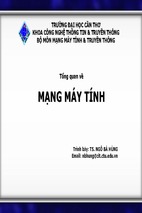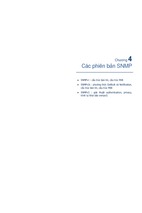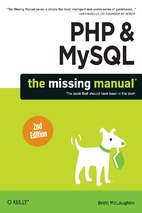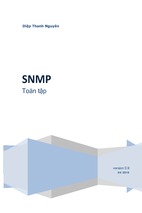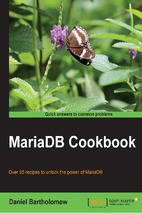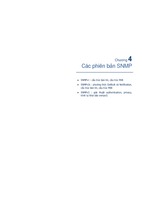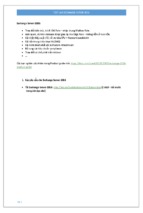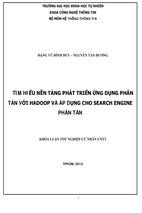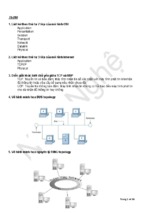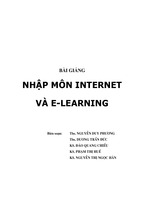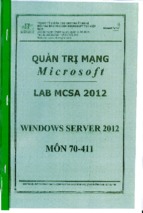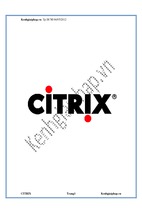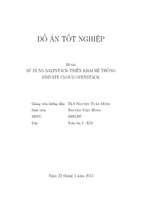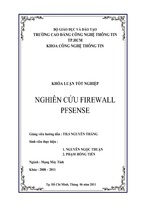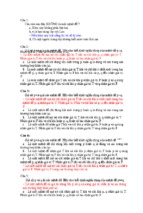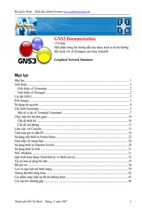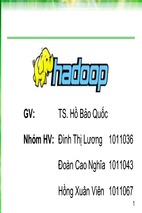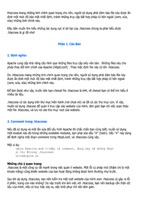Mô tả:
CCNA Test
CCNA – Basic Questions
http://www.9tut.com/basic-questions
Question 1
Which network topology allows all traffic to flow through a central hub?
A. bus
B. star
C. mesh
D. ring
Answer: B
Question 2
What is true about Ethernet? (Choose two)
A. 802.2 Protocol
B. 802.3 Protocol
C. 10BaseT half duplex
D. CSMA/CD stops transmitting when congestion occurs
E. CSMA/CA stops transmitting when congestion occurs
Answer: B D
Question 3
If a router has 3 hosts connected in one port and two other hosts connected in another port, how may
broadcast domains are present on the router?
A. 5
B. 2
C. 3
D. 4
Answer: B
Question 4
On which type of device is every port in the same collision domain?
A. a router
B. a Layer 2 switch
C. a hub
Answer: C
Question 5
Which MTU size can cause a baby giant error?
A. 1500
B. 9216
C. 1600
D. 1518
Answer: D
Question 6
What are three characteristics of the TCP protocol? (Choose three)
A. The connection is established before data is transmitted.
B. It uses a single SYN-ACK message to establish a connection.
C. It ensures that all data is transmitted and received by the remote device.
D. It uses separate SYN and ACK messages to establish a connection.
E. It supports significantly higher transmission speeds than UDP.
F. It requires applications to determine when data packets must be retransmitted.
Answer: A C D
Question 7
Which of the following statements describe the network shown in the graphic? (Choose two)
A. There are two broadcast domains in the network.
B. There are four broadcast domains in the network.
C. There are six broadcast domains in the network.
D. There are four collision domains in the network.
E. There are five collision domains in the network.
F. There are seven collision domains in the network.
Answer: A F
Question 8
A network interface port has collision detection and carrier sensing enabled on a shared twisted pair
network. From this statement, what is known about the network interface port?
A. This is a 10 Mb/s switch port.
B. This is a 100 Mb/s switch port.
C. This is an Ethernet port operating at half duplex.
D. This is an Ethernet port operating at full duplex.
E. This is a port on a network interface card in a PC.
Answer: C
Question 9
If there are 3 hosts connected in one port of a switch and two other hosts connected in another port,
how many collision domains are present on the router?
A. 5
B. 2
C. 3
D. 4
Answer: B
Question 10
What are contained in Layer 2 Ethernet frame? (Choose three)
A. Preamble
B. TTL
C. Type/length
D. Frame check sequence
E. version
F. others
Answer: A C D
Question 11
What interconnection cable can you use when you use a MDI connection?
A. cut-through
B. straight-through
C. crossover
D. rollover
Answer: C
Question 12
For what two purposes does the Ethernet protocol use physical addresses? (Choose two)
A. to uniquely identify devices at Layer 2
B. to allow communication with devices on a different network
C. to differentiate a Layer 2 frame from a Layer 3 packet
D. to establish a priority system to determine which device gets to transmit first
E. to allow communication between different devices on the same network
F. to allow detection of a remote device when its physical address is unknown
Answer: A E
Question 13
In an Ethernet network, under what two scenarios can devices transmit? (Choose two)
A. when they receive a special token
B. when there is a carrier
C. when they detect no other devices are sending
D. when the server grants access
E. when the medium is idle
Answer: C E
Question 14
How many broadcast domains are shown in the graphic assuming only the default VLAN is
configured on the switches?
A. one
B. six
C. twelve
D. two
Answer: A
Question 15
Which type of cable must you use to connect two device with MDI interfaces?
A. rolled
B. crossover
C. crossed
D. straight through
Answer: B
Question 16
Which statement about upgrading a Cisco IOS device with TFTP server?
A. the
B. the
C. the
D. the
operation is performed in active mode
operation is performed in unencrypted format
operation is performed in passive mode
Cisco IOS device must be on the same LAN as the TFTP server
Answer: B
CCNA – OSI & TCP/IP Model
http://www.9tut.com/osi-model-questions
Question 1
Which statements correctly describe steps in the OSI data encapsulation process?
A. The transport layer divides a data stream into segments and may add reliability and flow control
information.
B. The data link layer adds physical source and destination addresses and an FCS to the segment.
C. Packets are created when the network layer encapsulates a frame with source and destination host
addresses and protocol-related control information.
D. Packets are created when the network layer adds Layer 3 addresses and control information to a
segment.
E. The presentation layer translates bits into voltages for transmission across the physical link.
Answer: A D
Question 2
What layer of the OSI Model is included in TCP/IP Model‟s INTERNET layer?
A. Application
B. Session
C. Data Link
D. Presentation
E. Network
Answer: E
Question 3
Where does routing occur within the DoD TCP/IP reference model?
A. application
B. internet
C. network
D. transport
Answer: B
Question 4
Which of the following correctly describe steps in the OSI data encapsulation process? (Choose two)
A. The transport layer divides a data stream into segments and may add reliability and flow control
information.
B. The data link layer adds physical source and destination addresses and an FCS to the segment.
C. Packets are created when the network layer encapsulates a frame with source and destination host
addresses and protocol-related control information.
D. Packets are created when the network layer adds Layer 3 addresses and control information to a
segment.
E. The presentation layer translates bits into voltages for transmission across the physical link.
Answer: A D
Question 5
Which layer in the OSI reference model is responsible for determining the availability of the
receiving program and checking to see if enough resources exist for that communication?
A. transport
B. network
C. presentation
D. session
E. application
Answer: E
Question 6
Which networking technology is currently recognized as the standard for computer networking?
A. System network architecture
B. Transmission control protocol/Internet protocol
C. Open system Interconnect
D. Open network architecture
Answer: B
Question 7
Which three encapsulation layers in the OSI model are combined into the TCP/IP application layer?
(Choose three)
A. Session
B. Transport
C. Presentation
D. Application
E. Data-link
F. Network
Answer: A C D
Cloud & Virtual Services
http://www.9tut.com/cloud-virtual-services
Question 1
Which option is the benefit of implementing an intelligent DNS for a cloud computing solution?
A. It reduces the need for a backup data center.
B. It can redirect user requests to locations that are using fewer network resources.
C. It enables the ISP to maintain DNS records automatically.
D. It eliminates the need for a GSS.
Answer: B
Question 2
What are the three major components of Cisco network virtualization? (Choose three)
A. network access control
B. path isolation
C. virtual network services
D. policy enforcement
Answer: A B C
Question 3
Which three technical services support cloud computing?
A. network-monitored power sources
B. layer 3 network routing
C. ip localization
D. redundant connections
E. VPN connectivity
F. extended SAN services
Answer: D E F
Question 4
Which major component of the network virtualization architecture isolate users according to policy?
A. policy enforcement
B. network access control
C. network services virtualization
D. other
Answer: B
CCNA – WAN Questions
http://www.9tut.com/wan-questions
Question 1
Which command can you enter to determine whether serial interface 0/2/0 has been configured using HDLC
encapsulation?
A. router#show platform
B. router#show ip interface s0/2/0
C. router#show interfaces Serial 0/2/0
D. router#show ip interface brief
Answer: C
Question 2
Which Layer 2 protocol encapsulation type supports synchronous and asynchronous circuits and has built-in
security mechanisms?
A. X.25
B. HDLC
C. PPP
D. Frame Relay
Answer: C
Question 3
Which statements about using leased lines for your WAN infrastructure are true?
A. Leased lines provide inexpensive WAN access.
B. Leased lines with sufficient bandwidth can avoid latency between endpoints.
C. Leased lines require little installation and maintenance expertise.
D. Leased lines provide highly flexible bandwidth scaling.
E. Multiple leased lines can share a router interface.
F. Leased lines support up to T1 link speeds.
Answer: B C
Question 4
Two routers named Atlanta and Brevard are connected by their serial interfaces as illustrated, but there is no
connectivity between them. The Atlanta router is known to have a correct configuration. Given the partial
configurations, identify the problem on the Brevard router that is causing the lack of connectivity.
A. transmission unit size too large
B. no loopback set
C. an incorrect subnet mask
D. incompatible encapsulation at each end
E. an incorrect IP address
F. incompatible bandwidth between routers
Answer: E
Question 5
Which of the following describes the roles of devices in a WAN? (Choose three)
A. A CSU/DSU terminates a digital local loop
B. A modem terminates a digital local loop
C. A CSU/DSU terminates an analog local loop
D. A modem terminates an analog local loop
E. A router is commonly considered a DTE device
F. A router is commonly considered a DCE device
Answer: A D E
Question 6
Which two pieces of information are provided by the “show controllers serial 0” command? (Choose two)
A. the type of cable that is connected to the interface.
B. The uptime of the interface
C. the status of the physical layer of the interface
D. the full configuration of the interface
E. the interface‟s duplex settings
Answer: A C
Question 7
Which command is used to know the duplex speed of serial link?
A. show line
B. show interface
C. show protocol
D. show run
Answer: B
Question 8
Which WAN topology provides a direct connection from each site to all other sites on the network?
A. single-homed
B. full mesh
C. point-to-point
D. hub-and-spoke
Answer: B
Question 9
What are three reasons that an organization with multiple branch offices and roaming users might
implement a Cisco VPN solution instead of point-to-point WAN links? (Choose three)
A. reduced cost
B. better throughput
C. broadband incompatibility
D. increased security
E. scalability
F. reduced latency
Answer: A D E
Question 10
Which three statements about DWDM are true? (Choose three)
A. It allows a single strand of fiber to support bidirectional communications
B. It is used for long-distance and submarine cable systems
C. It can multiplex up to 256 channels on a single fiber
D. It supports both the SDH and SONET standards
E. Each channel can carry up to a 1-Gbps signal
F. It supports simplex communications over multiple strands of fiber
Answer: C D E
PPP Questions
http://www.9tut.com/ppp-questions
Question 1
Which two statements about using the CHAP authentication mechanism in a PPP link are true?
(Choose two)
A. CHAP uses a two-way handshake.
B. CHAP uses a three-way handshake.
C. CHAP authentication periodically occurs after link establishment.
D. CHAP authentication passwords are sent in plaintext.
E. CHAP authentication is performed only upon link establishment.
F. CHAP has no protection from playback attacks.
Answer: B C
Question 2
A network administrator needs to configure a serial link between the main office and a remote
location. The router at the remote office is a non-Cisco router. How should the network administrator
configure the serial interface of the main office router to make the connection?
A. Main(config)# interface serial 0/0
Main(config-if)# ip address 172.16.1.1 255.255.255.252
Main(config-if)# no shut
B. Main(config)# interface serial 0/0
Main(config-if)# ip address 172.16.1.1 255.255.255.252
Main(config-if)# encapsulation ppp
Main(config-if)# no shut
C. Main(config)# interface serial 0/0
Main(config-if)# ip address 172.16.1.1 255.255.255.252
Main(config-if)# encapsulation frame-relay
Main(config-if)# authentication chap
Main(config-if)# no shut
D. Main(config)# interface serial 0/0
Main(config-if)#ip address 172.16.1.1 255.255.255.252
Main(config-if)#encapsulation ietf
Main(config-if)# no shut
Answer: B
Question 3
Refer to the exhibit:
The Bigtime router is unable to authenticate to the Littletime router. What is the cause of the
problem?
A. The usernames are incorrectly configured on the two routers.
B. The passwords do not match on the two routers.
C. CHAP authentication cannot be used on a serial interface.
D. The routers cannot be connected from interface S0/0 to interface S0/0.
E. With CHAP authentication, one router must authenticate to another router. The routers cannot be
configured to authenticate to each other.
Answer: B
Question 4
What is the benefit of point-to-point leased line?
A. Low cost
B. Full-mesh capability
C. Flexibility of design
D. Simply configuration
Answer: D
Question 5
When you deploy multilink PPP on your network, where must you configure the group IP Address
on each device?
A. In the global config
B. Under serial interface
C. Under the routing protocol
D. Under the multilink interface
Answer: D
Question 6
What are two authentication types of MLPPP?
A. PEAP
B. LEAP
C. PAP
D. CHAP
E. TACACS+
Answer: C D
Question 7
At which layer of the OSI model does PPP perform?
A. Layer 2
B. Layer 3
C. Layer 4
D. Layer 5
E. Layer 1
Answer: A
Question 8
Which command is used to enable CHAP authentication with PAP as the fallback method on a serial
interface?
A. (config-if)# authentication ppp chap fallback ppp
B. (config-if)# authentication ppp chap pap
C. (config-if)# ppp authentication chap pap
D. (config-if)# ppp authentication chap fallback ppp
Answer: C
QoS Questions
http://www.9tut.com/pppoe-questions
Question 1
Which option describes the purpose of traffic policing?
A. It prioritizes routing protocol traffic.
B. It remarks traffic that is below the CIR
C. It drops traffic that exceeds the CIR.
D. It queues and then transmits traffic that exceeds the CIR.
Answer: C
Question 2
Which statement about QoS default behavior is true?
A. Ports are untrusted by default.
B. VoIP traffic is passed without being tagged.
C. Video traffic is passed with a well-known DSCP value of 46.
D. Packets are classified internally with an environment.
E. Packets that arrive with a tag are untagged at the edge of an administrative domain.
Answer: E
Question 3
What 8-bit field exists in IP packet for QoS?
A. Tos Field
B. DSCP
C. IP Precedence
D. Cos
E. ?
Answer: A
Question 4
Which feature can you implement to reserve bandwidth for VoIP calls across the call path?
A. round robin
B. CBWFQ
C. PQ
D. RSVP
Answer: D
Question 5
What does traffic shaping do to reduce congestion in a network?
A. buffers and queues packets
B. buffers without queuing packets
C. queues without buffering packets
D. drops packets
Answer: A
Question 6
In which byte of an IP packet can traffic be marked?
A. The CoS byte
B. The ToS byte
C. The DSCP byte
D. The QoS byte
Answer: B
Question 7
Which function does traffic shaping perform?
A. It buffers and queues excess packets
B. It buffers traffic without queuing it
C. It queues traffic without buffering it
D. It drops packets to control the output rate
Answer: A
Question 8
Which option is the main function of congestion management?
A. discarding excess traffic
B. queuing traffic based on priority
C. classifying traffic
D. providing long-term storage of buffered data
Answer: B
PPPoE Questions
http://www.9tut.com/pppoe-questions
Question 1
Which part of the PPPoE server configuration contains the information used to assign an IP address to a
PPPoE client?
A. virtual-template interface
B. DHCP
C. dialer interface
D. AAA authentication
Answer: A
Question 2
During which phase of PPPoE is PPP authentication performed?
A. the PPP Session phase
B. Phase 2
C. the Active Discovery phase
D. the Authentication phase
E. Phase 1
Answer: A
Question 3
Which type of interface can negotiate an IP address for a PPPoE client?
A. Ethernet
B. dialer
C. serial
D. Frame Relay
Answer: B
MPLS Questions
http://www.9tut.com/mpls-questions
Question 1
Which statement about MPLS is true?
A. It operates in Layer 1.
B. It operates between Layer 2 and Layer 3.
C. It operates in Layer 3.
D. It operates in Layer 2.
Answer: B
Question 2
Which two statements about MPLS are true? (Choose two)
A. It provides automatic authentication
B. It can carry multiple protocols, including IPv4 and IPv6
C. It encapsulates all traffic in an IPv4 header
D. It uses labels to separate and forward customer traffic
E. It tags customer traffic using 802.1q
Answer: B D
DMVPN Questions
http://www.9tut.com/dmvpn-questions
Question 1
Which type of topology is required by DMVPN?
A. ring
B. full mesh
C. hub-and-spoke
D. partial mesh
Answer: C
Question 2
Which circumstances can cause a GRE tunnel to be in an up/down state? (Choose three)
A. The tunnel interface IP address is misconfigured.
B. The tunnel interface is down.
C. A valid route to the destination address is missing from the routing table.
D. The tunnel address is routed through the tunnel itself.
E. The ISP is blocking the traffic.
F. An ACL is blocking the outbound traffic.
Answer: B C D
CDP & LLDP Questions
http://www.9tut.com/cdp-lldp-questions
Question 1
Which command would you configure globally on a Cisco router that would allow you to view directly
connected Cisco devices?
A. cdp run
B. enable cdp
C. cdp enable
D. run cdp
Answer: A
Question 2
Which statement about LLDP is true?
A. It is a Cisco proprietary protocol.
B. It is configured in global configuration mode.
C. The LLDP update frequency is a fixed value.
D. It runs over the transport layer.
Answer: B
Question 3
What is true about Cisco Discovery Protocol?
A. it discovers the routers, switches and gateways.
B. it is network layer protocol
C. it is physical and data link layer protocol
D. it is proprietary protocol
- Xem thêm -


